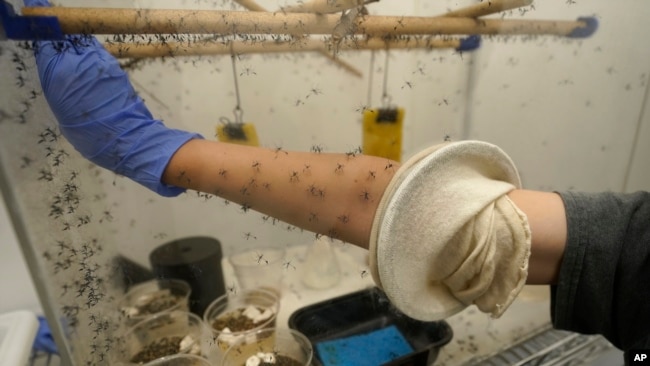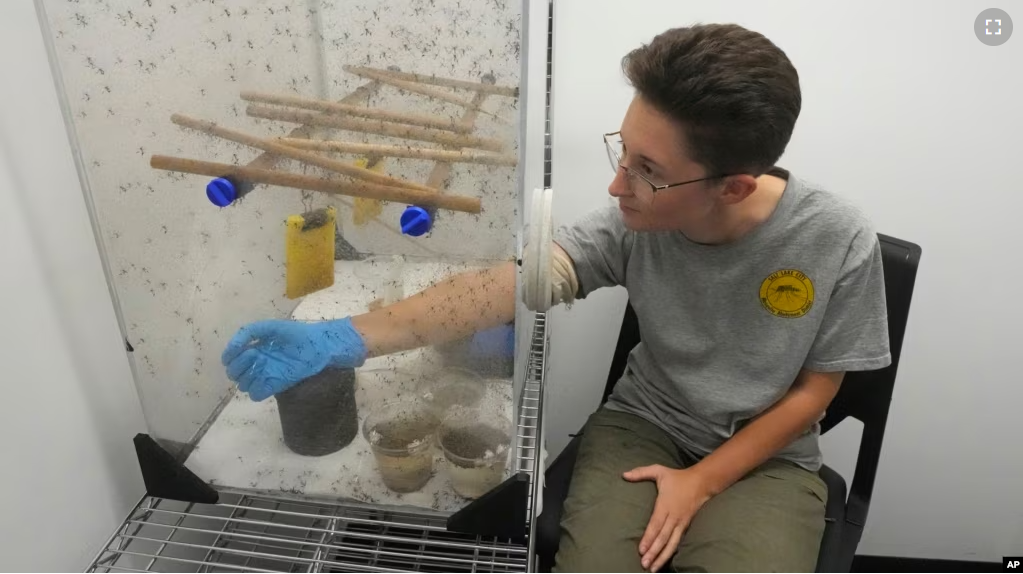It is lunchtime. And mosquitoes find their way to Ella Branham’s arm at a Salt Lake City lab in the American state of Utah.
“They’re not very aggressive and they’re kind of picky eaters,” said Branham. She breathed into a glass tank to attract the insects to the carbon dioxide in her breath. “So I’ll be feeding them with my arm.”
Branham had volunteered to let the South American mosquitoes, called sabethes cyaneus, feed on her blood. She is doing so to help produce eggs and maintain the colony for education and research at the Salt Lake City Mosquito Abatement District.
The district is one of many mosquito control areas around the United States that seek to control one of the world’s deadliest animals. Mosquitoes are expected to strengthen as climate change creates a warmer and wetter environment.
Mosquitoes can carry viruses including dengue, yellow fever, chikungunya and Zika. They are especially threatening to public health in Asia and Africa but are closely watched in the United States. Local agencies reported more than 1,100 cases of West Nile virus in 2022, says the U.S. Centers for Disease Control.

Most humans who get West Nile show no symptoms. But for some, it can cause vomiting, fever and in rare cases seizures or meningitis. Over roughly the last 25 years, nearly 3,000 deaths and more than 25,000 hospitalizations connected to West Nile were reported throughout the U.S., mostly in August.
West Nile deaths have been reported this year in states including Texas and Colorado. Mosquitoes are also thought to have caused malaria infections of people in Maryland, Florida and Texas.
Ary Faraji is a disease expert and the director of the Salt Lake City Mosquito Abatement District. He said the mosquito season is starting earlier and lasting longer as the climate has warmed. The district used to shut down each year in mid-September, but that has gotten later and later. Last year, district workers were still setting and checking traps until late November.

And this year, workers estimated that there were five times as many mosquitos in May compared to the average year. There was an unusually snowy winter in Salt Lake City and a very rainy spring that left more water for mosquitoes to breed in.
That is where the health threat comes in. While both males and females feed on sugar or nectar throughout their lives, females require blood to provide nutrition to their eggs.
The workers, including scientists and students, use drones, boats and vehicles to trap, sort and test mosquitos for viruses. Their work considers how things like weather systems and population growth will affect the spread of disease.
The more people there are close to a lot of mosquitos, the higher the chance of spread, Faraji said. The wetland areas surrounding Utah’s Great Salt Lake are problematic, he added.
Though dangerous, mosquitoes are also important to ecosystems throughout the world. Some serve as pollinators or food sources to fish, birds and frogs.
“We try to maintain a balance and suppress them to the point that they’re not negatively affecting communities,” Faraji said. “Taking them away would definitely negatively impact our ecosystem overall.”
I’m Dan Novak.
Dan Novak adapted this story for VOA Learning English based on reporting by The Associated Press.
_________________________________________________
Words in This Story
abate — v. to become weaker
district — n. an area established by a government for official government business
symptom — n. a change in the body or mind which indicates that a disease is present
vomit — n. to have the food, liquid, etc., that is in your stomach come out through your mouth because you are sick
breed — v. to produce offspring by sexual reproduction
pollinator — n. to give pollen from another plant of the same kind so that seeds will be produced
negative — adj. harmful or bad
